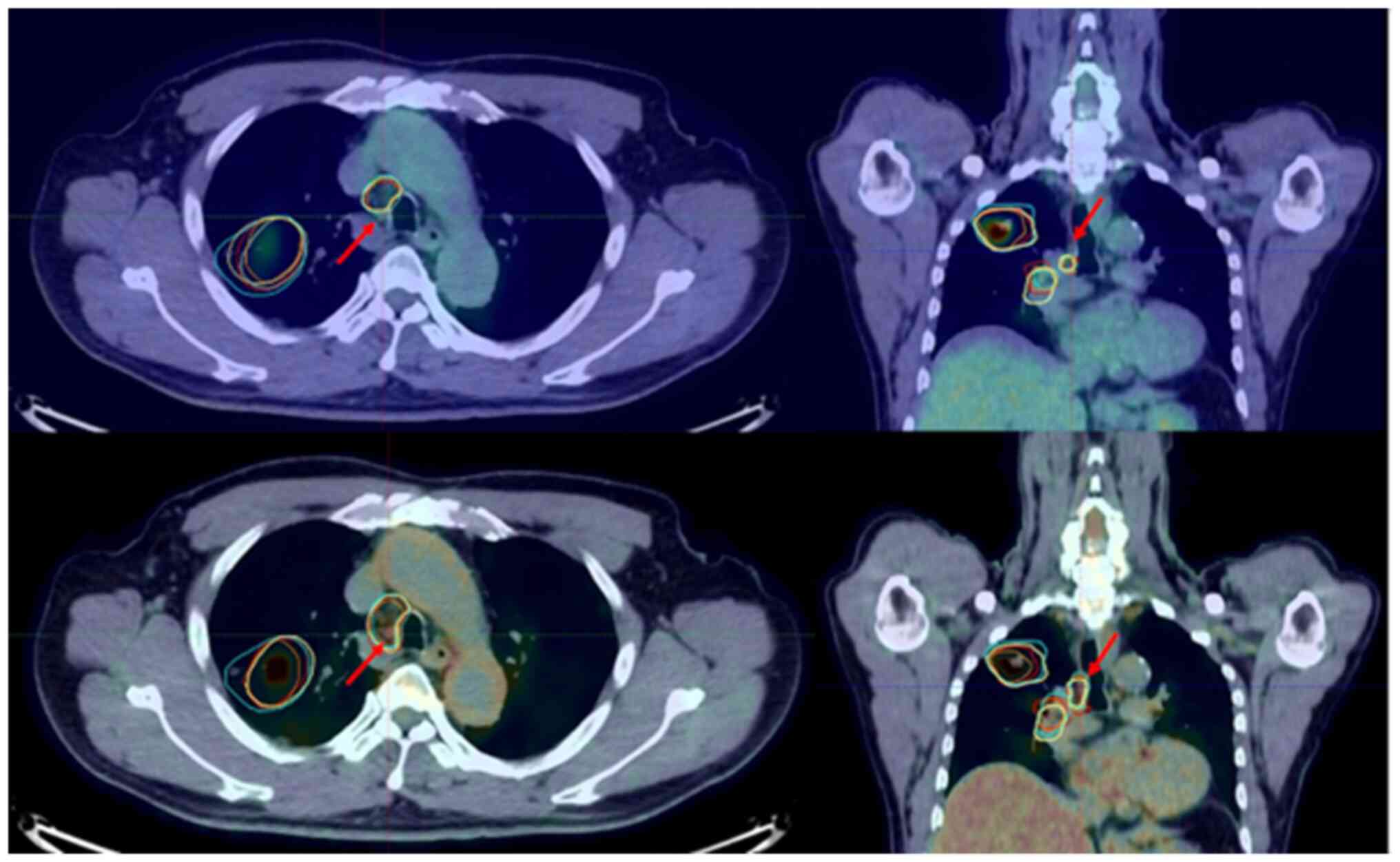|
1
|
Aupérin A, Le Péchoux C, Rolland E, Curran
WJ, Furuse K, Fournel P, Belderbos J, Clamon G, Ulutin HC, Paulus
R, et al: Meta-analysis of concomitant versus sequential
radiochemotherapy in locally advanced non-small-cell lung cancer. J
Clin Oncol. 28:2181–2190. 2010.PubMed/NCBI View Article : Google Scholar
|
|
2
|
Topkan E, Ozdemir Y, Guler OC, Kucuk A,
Besen AA, Mertsoylu H, Sezen D, Akdemir EY, Sezer A, Bolukbasi Y,
et al: Comparison of involved field radiotherapy versus elective
nodal irradiation in stage IIIB/C non-small-cell lung carcinoma
patients treated with concurrent chemoradiotherapy: A propensity
score matching study. J Oncol. 2020(7083149)2020.PubMed/NCBI View Article : Google Scholar
|
|
3
|
Abe T, Iino M, Saito S, Aoshika T, Ryuno
Y, Ohta T, Igari M, Hirai R, Kumazaki Y, Miura Y, et al:
Feasibility of intensity modulated radiotherapy with involved field
radiotherapy for Japanese patients with locally advanced non-small
cell lung cancer. J Radiat Res. 62:894–900. 2021.PubMed/NCBI View Article : Google Scholar
|
|
4
|
Yuan S, Sun X, Li M, Yu J, Ren R, Yu Y, Li
J, Liu X, Wang R, Li B, et al: A randomized study of involved-field
irradiation versus elective nodal irradiation in combination with
concurrent chemotherapy for inoperable stage III nonsmall cell lung
cancer. Am J Clin Oncol. 30:239–244. 2007.PubMed/NCBI View Article : Google Scholar
|
|
5
|
Konert T, Vogel W, MacManus MP, Nestle U,
Belderbos J, Grégoire V, Thorwarth D, Fidarova E, Paez D, Chiti A
and Hanna GG: PET/CT imaging for target volume delineation in
curative intent radiotherapy of non-small cell lung cancer: IAEA
consensus report 2014. Radiother Oncol. 116:27–34. 2015.PubMed/NCBI View Article : Google Scholar
|
|
6
|
Shiga T, Morimoto Y, Kubo N, Katoh N,
Katoh C, Takeuchi W, Usui R, Hirata K, Kojima S, Umegaki K, et al:
A new PET scanner with semiconductor detectors enables better
identification of intratumoral inhomogeneity. J Nucl Med.
50:148–155. 2009.PubMed/NCBI View Article : Google Scholar
|
|
7
|
Nguyen NC, Vercher-Conejero JL, Sattar A,
Miller MA, Maniawski PJ, Jordan DW, Muzic RF Jr, Su KH, O'Donnell
JK and Faulhaber PF: Image quality and diagnostic performance of a
digital PET prototype in patients with oncologic diseases: Initial
experience and comparison with analog PET. J Nucl Med.
56:1378–1385. 2015.PubMed/NCBI View Article : Google Scholar
|
|
8
|
Koopman D, van Dalen JA, Stevens H, Slump
CH, Knollema S and Jager PL: Performance of digital PET compared
with high-resolution conventional PET in patients with cancer. J
Nucl Med. 61:1448–1454. 2020.PubMed/NCBI View Article : Google Scholar
|
|
9
|
López-Mora DA, Carrió I and Flotats A:
Digital PET vs analog PET: Clinical implications? Semin Nucl Med.
52:302–311. 2022.PubMed/NCBI View Article : Google Scholar
|
|
10
|
Kanda Y: Investigation of the freely
available easy-to-use software ‘EZR’ for medical statistics. Bone
Marrow Transplant. 48:452–458. 2013.PubMed/NCBI View Article : Google Scholar
|
|
11
|
Grubbs FE: Sample criteria for testing
outlying observations. Ann Math Statist. 21:27–58. 1950.
|
|
12
|
Laurans M, Botticella A, Moukasse Y, Lévy
A and Le Péchoux C: Lung cancer and elective nodal irradiation: A
solved issue? Cancer Radiother. 23:701–707. 2019.PubMed/NCBI View Article : Google Scholar : (In French).
|
|
13
|
Wang L, Zhang M, Pan X, Zhao M, Huang L,
Hu X, Wang X, Qiao L, Guo Q, Xu W, et al: Integrative serum
metabolic fingerprints based multi-modal platforms for lung
adenocarcinoma early detection and pulmonary nodule classification.
Adv Sci (Weinh). 9(e2203786)2022.PubMed/NCBI View Article : Google Scholar
|
|
14
|
Li Y, Bao Q, Yang S, Yang M and Mao C:
Bionanoparticles in cancer imaging, diagnosis, and treatment. VIEW.
3(20200027)2022.
|
|
15
|
Huang J, Bao H, Li X and Zhang Z: In vivo
CT imaging tracking of stem cells labeled with Au nanoparticles.
VIEW. 3(20200119)2021.
|















